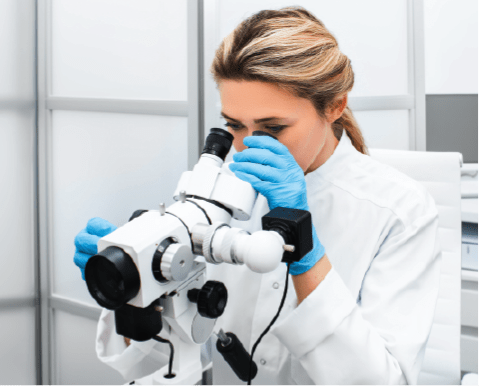Advanced laparoscopic surgery is also known as keyhole surgery or minimally invasive surgery because the entire surgery can be done without cutting open your abdomen.
Laparoscopic surgery is performed using a laparoscope, which is a thin and long tube approximately 5-10 mm wide with a camera attached to the tip. During surgery, a laparoscope is inserted into a small incision made in your abdomen, with the camera allowing the surgeon to watch the insides of your abdomen on a screen so they can either diagnose a gynaecological condition or perform surgery.
Benefits of laparoscopic surgery
Because laparoscopic keyhole surgery avoids the need for a more invasive abdominal open surgery, it reduces scarring, the chance of infection, post-operative pain and your overall recovery time.
When laparoscopic surgery is performed for diagnosis, two incisions are made, whereas for operative laparoscopies, three or four incisions may be required. Scarring from these incisions, if any, is minimal and barely visible.
Level 5 Advanced Laparoscopic Surgery
Dr Siva has a special interest in Advanced Laparoscopic Surgery and is an accredited Level 5 advanced laparoscopic surgeon, one of the highest levels of complexity for laparoscopic surgery.
Dr Siva uses Level 5 advanced Laparoscopic Surgery for diagnosis and treatment of complex gynaecological conditions such as:
- Pelvic adhesions
- Fibroids
- Endometriosis (laparoscopic excision of endometriosis)
- Adenomyosis
- Chronic pelvic pain
- Ovarian cysts (laparoscopic ovarian cystectomy, laparoscopic oophorectomy)
- Heavy periods.
These Advanced Laparoscopic Surgeries are all carried out in St Andrew’s Ipswich Private Hospital, Queensland.
Total Laparoscopic Hysterectomy (TLH)
Total Laparoscopic Hysterectomy (also known as TLH) is a surgical procedure for the removal of your uterus (womb) and sometimes also your cervix, which is the lower part of your uterus near your vagina.
Total Laparoscopic Hysterectomy is the route of choice rather than abdominal abdominal hysterectomy because a Total Laparoscopic Hysterectomy is associated with less pain, less blood loss and a faster recovery because your uterus is separated from the inside of the body and removed through your vagina.
Dr Siva performs Total Laparoscopic Hysterectomy to treat:
- heavy periods caused by uterine fibroids
- pelvic pain due to endometriosis, unsuccessfully treated pelvic inflammatory disease (PID), adenomyosis or uterine fibroids fibroids.
- prolapse of the uterus
Most hysterectomy cases can be performed laparoscopically and Dr Siva performs Total Laparoscopic Hysterectomy at the St Andrew’s Ipswich Private Hospital, Queensland.
Single Incision Laparoscopic Surgery (SILS)
SILS is a special form of laparoscopy that uses a single incision in the thinnest part of the abdomen – the belly button – through which all the instruments required for the operation are placed.
The main advantages of SILS are the improved cosmetic appearance after surgery by avoiding several scars near the bikini line, a reduction in pain following surgery and the possibility of a slightly faster recovery than with traditional laparoscopic techniques.
Dr Siva performs Single Incision Laparoscopic Surgery (SILS) for a wide range of gynaecological procedures including:
- ovarian cystectomy – removal of ovarian cysts and fibroids
- fertility evaluation
- ectopic pregnancy surgery
- hysterectomy
Advanced Laparoscopic Surgery FAQs
The majority of laparoscopic surgery cases are day surgery cases, however total laparoscopic hysterectomy is usually an overnight stay.
Laparoscopic surgery can take anywhere between 60-90 minutes, depending on the type of laparoscopic surgery you are having and any complications, such a the number of and size of adhesions.
A total laparoscopic hysterectomy usually takes around 90 minutes.
You may experience some vaginal bleeding for anywhere between a couple of days to up to one month after surgery. If this bleeding becomes heavy or you experience an unusual discharge, please contact Dr Siva’s rooms as this may indicate an infection.
Your next normal menstrual cycle may not occur until four to six weeks after surgery and you may experience heavier bleeding and more discomfort than usual.
Immediately after the surgery, you may feel sleepy and nauseous, with pain at the site of the incisions – you will be given pain-relieving medication for this. You may also experience a sensation of bloating in the abdomen or pain in the shoulder tips from the carbon dioxide gas used during a laparoscopy.
For the first 24 hours after you return home, have a responsible adult stay with you, rest quietly and don’t do any heavy lifting, housework, cooking or drink alcohol. Don’t drive, operate machinery or sign any important or legal documents.
Cuts on your abdomen will be closed by stitches or glue. Glue will dissolve by itself, while stitches may either dissolve or need to be removed in Dr Siva’s room five to seven days after surgery.
Your cuts will be covered with a dressing that can be removed 24 hours after your surgery, which is when you can also have a wash or shower.
If you have any stitches in your vagina they will dissolve themselves and you might see a stitch, or part of a stitch, coming away after a few days or weeks. This is normal and nothing to worry about.
Until you’ve had the sign off from Dr Siva at your post surgical review, don’t resume sexual intercourse, swimming, bathing or use tampons.
You will be permitted to resume sexual intercourse, swimming and bathing once your wound has fully healed, which is usually six weeks after surgery.
Avoid all vigorous activities for the first few weeks after your operation and avoid exercises such as sit-ups or lifting heavy objects until after your post surgical review.
Depending on the type of laparoscopic surgery, you should be able to return to driving and/or work 1-2 weeks after your procedure.
ANY FURTHER QUESTIONS?
Please feel free to get in touch with Dr Siva’s rooms via email ipswichgyn@gmail.com or call (07) 3816 9189
for any further questions about our appointments, fees or anything else.





